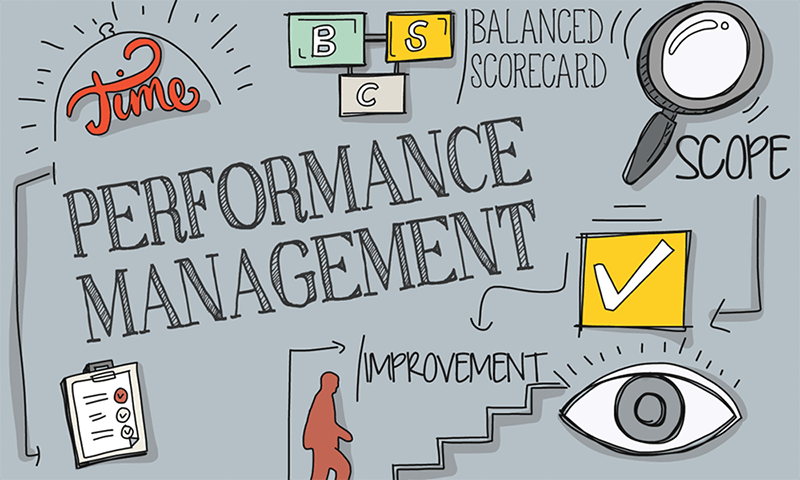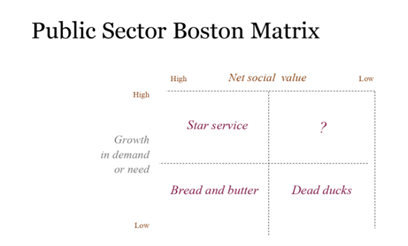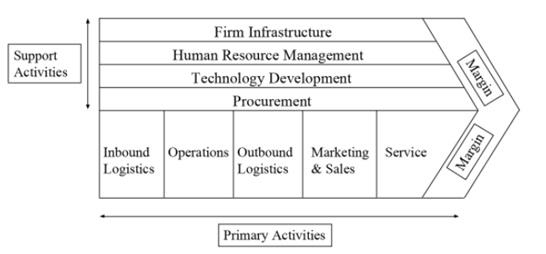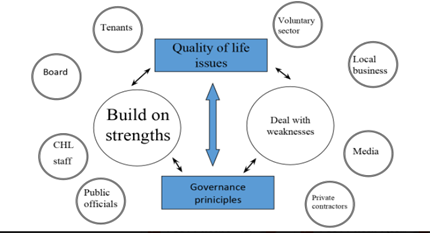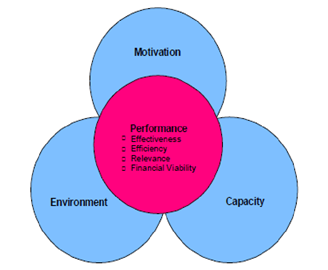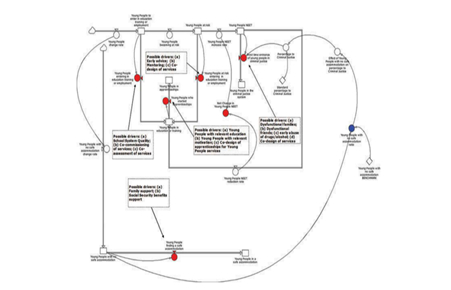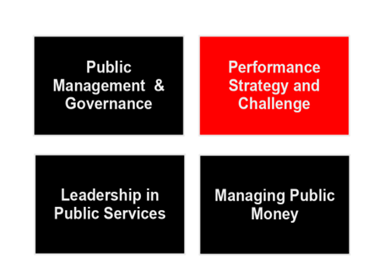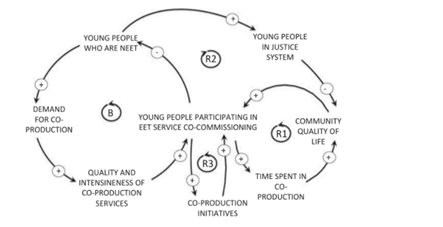Strategic and Performance Management in organisations
Part 1
Introduction
Strategic management in organisations has been significantly concerned with the long-term feasibility of substantive policy and management capacity. In other words, strategic management in public service organisations is usually influenced by two key approaches of rational thinking and generative thinking for the sake of planning of strategy in a complex business environment (Bovaird and Löffler, 2015). This part of the report discusses and evaluates the internal and external influences on organisations under which they operate. It, too, represents the organisational culture, market situation, with an analytical review considering all the aspects of the strategic management process.
Strategy as a Process
Lusk and Birks (2014) have mentioned that, considering the organisational context, the strategy can be considered as a process of events. The consideration of strategy as a process has been used to analyse the strategic management process of an organisation. The process model of strategy has defined that input for the development has influenced the activities and incurred a positive or negative output as per the effectiveness of the activity performed. Strategic management is the act of performing all these elements in a coherent way (Lusk and Birks, 2014). From the process approach of strategic management, after the measurement of the output, the effectiveness of the strategy can be measured through the indicator, which is the initial analysis of the effectiveness of the strategy. That initial strategic measurement has identified the intermediate outcomes and led to the outcome of the strategic management.
Image 1 Strategy as a process
(Source: Lusk and Birks 2014)
Strategy Development and Strategic Role
The desire for improvement and aim for resolving the issues give rise to the consideration of the strategic management approach within an organisation. But the development of strategic management can be evaluated from two important perspectives. Rational thinking and generative thinking have been taken as the important aspects behind the development of the Strategic management approach of an organisation (Gratton, 2018). The analytical approach of rational-based thinking has improved the understanding of the different needs of the management division of an organisation, whether the intuitive-based approach of generative thinking has considered creativity over the logic to define the strategic management approaches. Above all, the intuitive approach and the rationale-based approach both have a consideration about the problems and issues to formulate the impeccable solution.
The strategic management approach has developed different informative situations for the organisation based on a strong understanding of the prevailing situation and issues—the selection of a specific strategy for strategic development. Understanding the organisational circumstances has offered a chase to identify the possibilities for strategic development. Scholes and Johnson (2001) have mentioned that assessment of the suitability of the available opportunities has played a significant role in the strategic management opportunity of a firm (Gratton, 2018). The strategic management approach has a significant role in organisational management as it has been attributed to keeping the ingenuity, inclusivity of the management approach. Through the analysis of the risks and threats to the organisation, the strategic management process has enabled combat with the perceptual barriers and cultural barriers within the organisation that block the power transition and over-commitment solution issues of the organisation (Scholes and Johnson, 2001).
Strategic management and Boston Matrix
In the corporate environment, culture has been taken as an important aspect, and it too has more complexities. Bovaird and Löffler (2015) have suggested that strategic management choices have different forms and structures in different fields. As in the corporate sector, the strategic management approach has considered the relationship approach between the center and the subsidiaries and diversification approach, where the strategy of the service sector has been formed based on the competitive advantages (Sakalayenet al., 2017). But the strategic implementation in a Public sector or a corporate sector has been evaluated through the Boston Matrix of the Public sector, which has considered growth and demand as a parameter to evaluate the social values and social development. Bovaird and Löffler (2015) suggested that the strategy that has higher social value as well as the higher growth curve has been termed as start service and adopted that strategy for the organisational performance management.
Image 2 Boston Matrix
(Source: Bovaird and Löffler, 2015)
Influence of External Environment
Strategic management options have been taken to achieve a competitive advantage in the market. That competitive advantage can be gained with the analysis of the external environment analysis. The PORTER’s five forces model has determined the market condition of a corporate and the stability of a business under the competitive scenario (Sakalayenet al., 2017). PESTEL is an important element for external environment analysis. In the environment in which an organisation operates, the external influences are the political factors, economic strength, and social culture of that region. Based upon the analysis of these elements has offered an insightful view of the contemporary context of the market. Pan et al. (2019) has opined that identification of those environmental factors has defined opportunities and threats imposed by the environment. So, the analytical approach of the external environment of the firm defined the likeness of the strategies for market dominance.
Value Chain Analysis and Strategic Management
Image 3 value Chain Analysis
(Source: Mohelska and Sokolova, 2018)
Based on the analytical tools and frameworks for the external environment analysis, the nature of the environment can be identified whether the nature of the environment is Dynamic or Complex. Appiah et al. (2018) has mentioned different types of the external environment for the strategic development of SMEs. But the analysis of Appiah et al. has suggested that understanding the nature of the external comment has influenced the value chain analysis of the organisation structure and the organisational culture. Mohelska and Sokolova (2018) have commented that the organisational culture has influenced the value proposition of the firm as well as the decision-making approach of the firm. So, the Strategic management approach has an intense connection with the value chain analysis of a firm.
Conclusion
The stability in the competitive rivalry has been identified by Porter’s five forces analysis, where the degrees of competition have been disclosed for the strategy identification. The strategic management approach, as per the analysis of the external environment, has defined whether the service or the business would be serving values to the customers or stakeholders or to the distributors to sustain the competitive market. Hence, the strategic management approach of a firm is the collective effect of the organisational culture, external analysis, and the competitive rivalry situation surrounded the organisation.
Part 2
Introduction
Organisational performance has been performance in complying with the organisational goals and strategic objectives. The performance of the organisational activities has influenced the organisations to move towards the fulfilment of goals. It has a demonstrated history, and the process of management has changed over time. The present review of performance management has considered the historical aspects as well as the present context of performance management.
History and Relevance
Performance management has been used in the organisational perspective for business organisations and other forms of organisations from 1970-the 80s, and after that, the usage of this phrase has been widely increased. In the twenty-first century, it has been considered an important aspect of organisational operation (Renshaw, 2019). During the 1900s to 1940s, the facts about social issues have been identified. The social issues regarding the performance and the condition of the employees at the workplace have been considered with prime importance. The social survey movement has happened, and the term performance management has become prominent. In 1903, Charles Booth wrote a note on this perspective, and that has been taken as an important document for this perspective (Renshaw, 2019).
Scientific Performance management
In the 1940s, the attitude of accepting science as an important tool of social life has changed the performance management approach and has been adopted as an important aspect. When the government of the different countries has proposed to accept the scientific facts over the adhocracy, the development of the scientific management has been ensured. Cost accounting practices have been included in the performance management approach, and specifically, the survey movement has influenced the scientific performance management aspect of the organisations. Nielsen (2018) has mentioned that the performance of the employee can be developed by supporting the employees and offering equality in the workplace to the employee. The rights to access equal opportunity have ensured the security of the employees at the workplace. The performance can be improved. Hopper (2020) has mentioned that each of the employees has improved their performance for their basic needs. In his paper, Hopper also mentioned the Maslow Hierarchy of the basic needs and mentioned that performance management had been formed based on the primary needs of employees. Every performance management approach has been formed with the consideration of the basic needs of humans.
Image 4 Motivations of Performance management
(Source: Aleksandrov et al., 2020)
Performance Budgeting
Employee performance would not be enough for the performance management of an organisation. Hence, the operational management of the organisation and the management of the different activities have also been considered for this purpose. From the 1950s to the 1970s era, the development of the performance budgeting approach has been considered as an approach to organisational performance management (Aleksandrov et al., 2020). The focus on the outputs based on the inputs imparted to the organisation has determined the level of performance of an organisation, along with the inputs and outputs of the organisation, the planning programming budget of an organisation (Ho, 2018). The performance budgeting approach has also considered that the specific framework for the executive decision-making could be influential for the long-term policy orientation and achievement of the organisational goal (Ho, 2018). Along with it, the MBO aspect of the performance management has considered that the performance of an organisation could be controlled by the managers of a firm, and the lack of performance and ineffectiveness observed in the performance management has been counted as the failure of the manager.
Zero Based Budgeting
Ibrahim (2019) mentioned Zero-based approach of performance budgeting could be applied to almost every kind of organisation, where the organisational performance can be calculated and budgeted from scratch. The priorities of the program and the spending on the alternative programs can be specified by the understanding of the current funding process (Beredugoet al., 2019). So, about the budgetary base, this zero-based approach has indicated the capability of the managers and administrative bodies regarding their capabilities of handling the budget for effective performance management.
Image 5 Process of Performance management
(Source: Beredugoet al., 2019)
Modern Performance Management
The modern performance management approach has considered the evidence-based policy for the performance approach. The performance management approach has been developed by third-way politics. As a part of the modern performance management approach, the evidence-based approach of performance management has considered ideologies as a part of performance management (Gratton, 2018). Based on the selected examples and evidence, the performance has been modified. Revisionism is another aspect of the performance management approach, through which the performance of a firm has been managed with the review and revision (Abdalmenemet al., 2019). This approach to performance management has been developed in the first decade of the twenty-first century. Austerity politics has been embedded into the policies and practices for the improved performance management approach. Armchair auditors have considered the open data approach for performance management through the Revisionist approach of performance management.
Dynamic Performance Management
Public service organisations have adopted the dynamic performance management technique. Social structure and the social complexities have related to the organisational performance of public service organisations. Consideration of the common social goals and the performance to achieve those social goals have related to the performance management of the public organisations (Sardi and Sorano, 2019). Based on the contemporary performance of public service organisations or the social structure, dynamic management has an approach to focus on the ways of improvement. Sardi and Sorano (2019) opined several degrees of complexities had been related to the public service organisation that has provided ideas for the dynamic system in getting feedback for the proposed performance management approach.
Conclusion
Conceptual stability about the management and the understanding of the different existing policies has improved the functionality of the performance management approach. Performance is dependent on various aspects and various topics, based on which the development of an organisation can be ensured. But adherence to the organisational policies is required for the strategic performance management approach. But when technological evolution has occurred, technologies like GIS, Big data, and Corporation management have taken the place of the traditional performance management approach.
Part 3
Introduction
Drawing attention towards performance management, in the light of a public service case study on the dynamic performance management approach that has been taken to combat ‘Wicked Issues’. The selected article has been published under the Routledge publishing house in the year 2017. Google scholar can be used to find the article by its name, “Applying a Dynamic Performance Management Framework to Wicked Issues”. Contextual discussion on the co-production process as a way out for the transformation of the young people services at Surrey County Council of the United Kingdom. The abstract is the snapshot of a paper, which has illustrated that the DPM approach has offered a time-relevant understanding of the issues related to the performance. The connection of the Surrey County Council with the public governance has made the article relevant for the present perspective. Bianchi, Bovaird, and Loeffler (2017) have authored this article considering the performance management perspective in the public service context of the UK.
Background of the Case Study
Public governance and public service organisations have a connection with social life. Dynamic complexities of society have created dynamic issues in performance management. Problems related to the social structure and governmental planning have been identified as the ‘Wicked Problems’. Higher degrees of complexities and dynamic issues have been related to it, which has made it unsolvable with the sole attempt of an organisation (Bianchi et al., 2017). The correlation of multi-factors, multi-level and intersectoral challenges have created more complexities in the ‘Wicked Problems’ (Bianchi et al., 2017). Issues embedded with the social structures of modern society have modified the approach of policymakers in decision-making. SYP of Surrey had encountered big trouble in the year 2009, where the budget cuts were experienced by them, and it had imposed a strong disadvantage on the young people of Surrey. Budget cuts and newly structured political infrastructure had created a social issue with a 60% reduction in the NEET, and apprenticeships had been increased by 30% (Bianchi et al., 2017). The social status was also outstanding at that point with the less number of homeless people, and the power level of substance misuse had been observed in the social structure of the Surry. But the destination had turned out to be a “Wicked Situation” with the complexities that arose in the society. The transport network was not good and reliable. Moreover, the drug issues and bullying were destroying the social decorum of Surry.
Relevance to the Concepts
Public administration and management of public institutions are not easy jobs. The relevance of the social issues has made the public administration to be trapped in wicked problems. The policymakers for the public administration have projected long-term goals for the operation of the organisation, but the issues have been encountered in the short-term responses. Challenges faced by the social structure of the public administration are concerned with different forms of the performance management approach. The decision-makers have selected a multifaceted performance management approach before the fixation of any specific rules for the public administration. In addition to this, the Public management approach has been focused on the 3E approach, which has considered effectiveness, economy, and efficiency. Performance auditing of the public service organisations has also been performed. The selection approach of the public service opportunities has been placed on the outcome-based approach. A dynamic approach has been adopted in the strategic management approach of a public service organisation that has suggested that the organisation should have specific goals and objectives regarding social security for the improvement of social outcomes. The goals and objectives have aligned the organisation to work smoothly towards achieving organisational goals. The goals are the long-term service facilities that need to be incorporated in the decision-making approach for the improvement of the outcomes (Abdalmenem et al., 2019). Focussing on the good governance approach and the aim of social development, the dynamic approach of performance management has been observed in the selected case. Quality of life outcomes of the youth population of the country has identified the relevance of co-production strategies of performance management.
Issues Encountered in the Case Study
A holistic approach for the improvement of the youth population of the UK had been adopted in Surrey for the improvement of the social position of the youths in society. Despite the holistic approach of the society and the good governance, 10% of the Surrey young people had remained disadvantaged as they could not successfully transition into adulthood. Complexities had been observed in the social structure of Surrey as the transportation system was not reliable, bullying and crimes had impacted the social balance. Whilst in such a problematic environment, 90% of the youth population had reached adulthood, where the rest, 10%, had remained vulnerable to transit them into adulthood. The commission had identified that the majority of the people who were unsuccessful in transmitting into adulthood had experienced some form of needs and demands. The major reason behind the unsuccessful transition of a significant number of youth to adulthood had been caused by the extreme marginalization approach of the society. Engaging the vulnerable young people with the successful transited young people, the co-productivity can be increased.
Analytical approach for the solution of the issues encountered
A performance management approach has been developed with the below-mentioned aspects. The general theory of performance management has diverse attitudes, which includes learning and knowledge management as an important tool for performance management. Gnoffo (2021) has identified outcome-based approach has improved the performance of public service organisations. A system-wide approach has been required to improve the performance of the preliminary solution model. Implementation of the DPM approach has improved the performance of the co-production strategies for the public service organisations. Along with it, outcome-based management and performance budgeting are the important aspects of performance management (Medveckáet al., 2017). Management objectives of the public service organisation have been aligned to the need of customers and the demand of the changed situation, as different activities of the organisational performance have been impacted, so the evidence-based approach of performance management has been adopted.
Dynamic Performance Management
A dynamic performance management approach has been taken to make the process of performance management a running process, where the inflows and outflows can be controlled. Dynamic performance management approach has been formed with three steps, where the temporal champions of the initial performance management approach have considered two outflows of the youth population from the stock of the total youth population. The social structure and the performance of the public administration process could increase the volume of outflow of the youths into education and employment (Bianchi et al., 2017). The very first approach of the DPM is that the policymakers should have to enhance the outflow of the people into development and education. This performance management step had a massive impact on minimising the youths at risk.
In the second step of the DPM, the major concern of the policymaker would be focussed on the youth at risk, rather than the focus on the youth failing at employment and education (Bianchi, 2016). Lowering the glow of the youths towards the risk situation, the social improvement can be improved where the NEET percentage would be very less.
Figure 1 Approach of performance management of Surry
(Source: Bianchi et al., 2017)
Strategic implementation of these two above-mentioned stages has been reflected in the end step, where the number of people at the NEET situation would be very less, and the number of the people having the excellence for employment and training would be increased (Bianchi et al., 2017). The direct consequences of the increased flow of the youths towards the stock of having education and training have optimised the participation of the youths in the apprentice activities.
Performance Management Drivers and Strategic Resourcing
For the performance through the DPM approach as per the situational need, a strong focus has been required to be given on the performance drivers to improve the performance of the dynamic performance. Four major drivers of the performance management in the public service organisations have been mentioned in the diagram below, which has depicted governance and strategic identification have been required for the improvement of the DPM (Mawed and Al-Hajj, 2017). Leadership approaches to align the organisations as per the organisational strategy have managed the public issues in a better way.
Figure 2 Performance management drivers
(Source: Bianchi, 2016)
Strategies are long-term goals for performance management. The above-mentioned step of the DPM, the strategy of the organisation, is to enhance the effectiveness of the organisational performance (Mahmoud et al., 2019). Quality of education and intensiveness of the learning and training quality could improve the performance of the enrolled students for the training and education process. Quality and intensiveness could be enhanced with the co-commissioning of the young people in education; the consideration of the co-assessment facilities could offer the opportunity for mutual improvement (Bianchi, 2016). The result of the second can be improved by minimising the number of the youth failing at the education, and the training facility center could be improved by the implementation of the strategic directions, such as the improvement of the quality of the education and the training facility, as the maximisation of the training facility centers. Flexibility in performance management could be achieved by maintaining the balance at the end of each step of the DPM (Bianchi et al., 2017).
The evidence-based policy of performance management
Observing the evidence related to the performance of the youth’s approach to the DPM could be altered. The performance management approach of Surrey had been considered to utilise the information received after the training of the youths at the educational and training centres (Noto and Noto, 2019). A generic model has been developed for performance management, where the identification of the stakeholders to the performance has been identified. It has simply offered great scope for the policymakers to understand the situation in detail to improve the system further for the development (Abdalmenemet al., 2019). It will enhance the functionality of the system. The outcome-based policy has considered the performances of the system adopted for implementation and then assess the different outcomes related to the performance. Understanding the outcomes has identified the available strategic opportunities for policymakers of Surrey and recognises the challenges to implementing the new strategic options (Dinshawet al., 2014). Evaluation of the contemporary evidence of the performances has identified the consistency and feasibility of the available options for implementation.
Performance Budgeting
Performance budgeting of the company has also been performed for the anticipation of the future performance management approach of the organisation. Boyne (2002), has identified that when an organisation has to perform in the public domain, the organisational environment has been changed. Complexities in the stakeholders’ needs and more bureaucracy have impacted the organisation structure, which also impacted the lower autonomy in the managerial performance (Abdalmenemet al., 2019). Managerial values of an organisation with a publicans’ approach have a public service ethos in their managerial values with a Lower materialism approach. The performance budgeting of the public service organisations has considered learning and steering and accountability to maintain transparency in the service. Mahmoud et al. (2019) mentioned the performance budgeting has considered that simulation of the business activities would improve the functionality of the system (Noto and Noto, 2019). As a part of the performance budgeting, an influence diagram has been adopted through the feedback loop process. The approach of the co-production process, which has been advised as an important driver for performance management, could be accessed through this diagram.
Figure 3 Feedback loop
(Source: Bianchi et al., 2017)
Bloop has identified that mid-term outcomes could be achieved with the performance commissioning approach through cooperation. The co-production and commissioning process would minimise the people who are the stock of the NEET (Bianchi et al., 2017). The reduction of the NEET has increased the demand for improvement, which would be reflected in the further reduction of the NEET population. Performance drivers could be intensive with the adoption of these strategies again in the organisational performance (Bianchi, 2016).
Along with the balanced loop, B, the three other loops have also been included in it, which are the R1, R2, and R3, which have created an amplified co-production process. R1 is the identification of higher engagement of the youth population to the co-commissioning process, where the R2 has introduced the process of reduction of the people at the criminal justice system with the reduction of the people at the NEET segment. R3 has an approach to improve the co-commissioning process so that the co-production initiatives can be improved (Bianchi et al., 2017).
Feasibility of the Solution
The act of performance management has been adopted by the organisation for the improvement of the social status of the youth population and their engagement in the apprentice activities. The issues and drawbacks to the contemporary situation have made the youths less engaged with the training and education process (Medveckáet al., 2017). In such cases, the approach of performance management has enhanced performance and developed improved management of performance by enhancing the less outflow of the youth population to the risk situation (Mahmoud et al., 2019). The interest of policymakers in the performance of the youth population in the educational field and training process has been enhanced. Surrey has also analysed the feedback loop to understand the degrees of engagement of youth.
Conclusion
An outcome-based approach to the performance improvement policies and regulations process has considered the different scenarios of the operational issues. But the analytical approach about the performance management of Surrey has identified a fact that the public organisations can improve their performance with their strong attachment to the social development aspect. Evaluation of the available information has monitored the performance analysis and suggested further improvement aspects. The major issues related to Surrey were inefficient management and increased social complexities.





